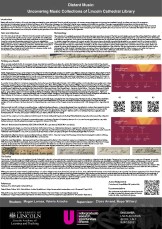By Megan Lomas & Valerie Arindra //

 The cathedral is one of, if not the most notable of Lincoln’s landmarks, geographically, culturally and historically. And music is no small part of its contribution and legacy. There have been many prolific composers, organists and choirmasters throughout Lincoln Cathedral’s lifetime and yet there is little record to be found of them and their music online. So, we set out to rectify this knowledge gap by researching the cathedral’s vast archives and digitising our findings. Considering the quantity of information and documentation, we knew we couldn’t finish the task in one summer, so our aim was not to complete it but to prepare a foundation for future research.
The cathedral is one of, if not the most notable of Lincoln’s landmarks, geographically, culturally and historically. And music is no small part of its contribution and legacy. There have been many prolific composers, organists and choirmasters throughout Lincoln Cathedral’s lifetime and yet there is little record to be found of them and their music online. So, we set out to rectify this knowledge gap by researching the cathedral’s vast archives and digitising our findings. Considering the quantity of information and documentation, we knew we couldn’t finish the task in one summer, so our aim was not to complete it but to prepare a foundation for future research.
 There exist 223 volumes of uncatalogued manuscripts and 60 of printed music in the Cathedral Library. While we obviously couldn’t inspect them all, as well as the fact that library visits were limited due to pandemic guidelines, our staff supervisor at Exchequer Gate photographed as many documents as she thought useful, as well as any specific files we requested to be uploaded to a shared OneDrive.
There exist 223 volumes of uncatalogued manuscripts and 60 of printed music in the Cathedral Library. While we obviously couldn’t inspect them all, as well as the fact that library visits were limited due to pandemic guidelines, our staff supervisor at Exchequer Gate photographed as many documents as she thought useful, as well as any specific files we requested to be uploaded to a shared OneDrive.
We started with the indexes, tables of contents and bibliographies of the original material and listed what composers we could find there. With hundreds of names, it was a Herculean task to say the least, so at some point we had to call it a day and work with what names we had. We identified composers that were particularly prolific in Lincoln and focused on those. Oxford Music Online was an especially indispensable tool for our secondary research, particularly for lesser-known composers.
At the same time, we had to research how to write a collection-level description as well as decide how we were going to display and format the collection. It was particularly difficult researching how we would go about writing the collection-level description as we had not yet completed a sufficient depth of research for the whole collection. As for displaying the collection, we looked at examples of other archives from cathedrals that had a similar standing to Lincoln.
The difficulties we faced with not having access to the source material ourselves created a disparity between our expectations for what we’d undertaken, and reality. We expected a much more hands-on research project, with the bulk of the work being digitising the original source material. We also had to determine exactly what to focus on as the sheer volume of material was certainly overwhelming at times.
Additionally, working on a non-science-based project meant that we had to interpret the briefs differently to fit our research. Displaying our data has also been a challenge as we can’t rely on the visual impact of graphs and charts like many of our peers on this programme.
It was disappointing that we didn’t have enough time or opportunity due to the world circumstance to work with more choirs or similar groups to really bring the music to life. Despite all obstacles, our supervising staff have truly been so supportive and helpful, and we couldn’t have done it without their expertise.
*To view Megan and Valerie’s research poster and presentation recording, please click on the thumbnails below:

